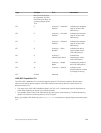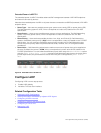
Extended Power via MDI TLV
The extended power via MDI TLV enables advanced PoE management between LLDP-MED endpoints
and network connectivity devices.
Advertise the extended power via MDI on all ports that are connected to an 802.3af powered, LLDP-MED
endpoint device.
• Power Type — there are two possible power types: power source entity (PSE) or power device (PD).
The Dell Networking system is a PSE, which corresponds to a value of 0, based on the TIA-1057
specification.
• Power Source — there are two possible power sources: primary and backup. The Dell Networking
system is a primary power source, which corresponds to a value of 1, based on the TIA-1057
specification.
• Power Priority — there are three possible priorities: Low, High, and Critical. On Dell Networking
systems, the default power priority is High, which corresponds to a value of 2 based on the TIA-1057
specification. You can configure a different power priority through the CLI. Dell Networking also
honors the power priority value the powered device sends; however, the CLI configuration takes
precedence.
• Power Value — Dell Networking advertises the maximum amount of power that can be supplied on
the port. By default the power is 15.4W, which corresponds to a power value of 130, based on the
TIA-1057 specification. You can advertise a different power value using the max-milliwatts option
with the
power inline auto | static command. Dell Networking also honors the power value
(power requirement) the powered device sends when the port is configured for power inline
auto.
Figure 73. Extended Power via MDI TLV
Configure LLDP
Configuring LLDP is a two-step process.
1. Enable LLDP globally.
2. Advertise TLVs out of an interface.
Related Configuration Tasks
• Viewing the LLDP Configuration
• Viewing Information Advertised by Adjacent LLDP Agents
• Configuring LLDPDU Intervals
• Configuring Transmit and Receive Mode
• Configuring a Time to Live
• Debugging LLDP
552
Link Layer Discovery Protocol (LLDP)


















